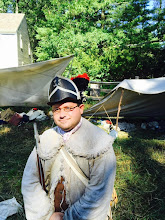
 This incredibly crisp and detailed image of sharp dressed gentleman was taken by "H.L.D. Shephard, Photograph Saloon, South Boston" sometime during the Civil War. What really strikes me about this man is his eyes, which are a bit eerie to me. They must have blue eyes because you can even see his pupils up close! His face bears a uncanny resemblance to Daniel Day Lewis' character "Bill the Butcher" in the amazing movie The Gangs of New York, who was based on a real historical figure in New York City who used that nickname. His real name was William Poole, who was an American butcher, boxer, and gangster. Poole was a devout member of the "Know-Nothing" party during the 1850s, which was very anti-immigrant and xenophobic, especially towards the Irish, which is more than evident in the movie. Poole did die under violent circumstances in 1855, and to learn more, visit http://herbertasbury.com/billthebutcher/billp.asp.
This incredibly crisp and detailed image of sharp dressed gentleman was taken by "H.L.D. Shephard, Photograph Saloon, South Boston" sometime during the Civil War. What really strikes me about this man is his eyes, which are a bit eerie to me. They must have blue eyes because you can even see his pupils up close! His face bears a uncanny resemblance to Daniel Day Lewis' character "Bill the Butcher" in the amazing movie The Gangs of New York, who was based on a real historical figure in New York City who used that nickname. His real name was William Poole, who was an American butcher, boxer, and gangster. Poole was a devout member of the "Know-Nothing" party during the 1850s, which was very anti-immigrant and xenophobic, especially towards the Irish, which is more than evident in the movie. Poole did die under violent circumstances in 1855, and to learn more, visit http://herbertasbury.com/billthebutcher/billp.asp.The man in this photo, however, was possibly Irish, as were most residents of South Boston during the nineteenth century. He was apparently fairly affluent as his nice coat with a velvet collar, silk tie and watch chain indicate. Where he was really from, and who he was we'll never know!







.jpg)


